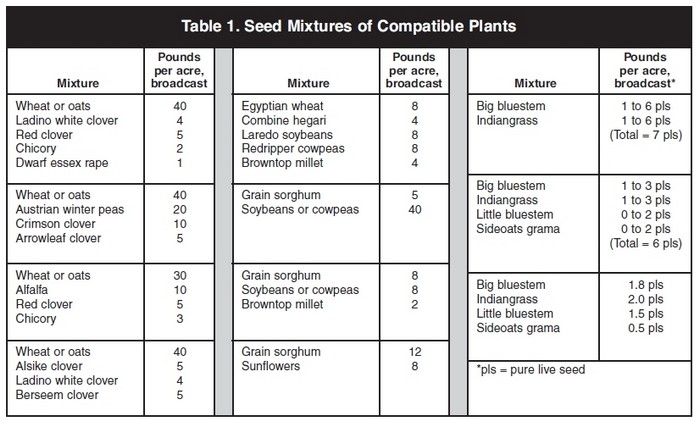Most hunters know that nothing beats a food plot because a high quality food source will always draw game in for harvest. But as great as food plots are, they do not plant themselves. They do take planning, as well as work, and the right food plot seed. There is no such thing as a one-size-fits-all seed for every wildlife species out there. Each plot and plant seeded must be selected for the wildlife species of concern, the environment and the specific soil type.
Food plots that consists of several plants are preferred over single plant, monoculture plots. However, not all seeds can simply be thrown together and planted. They must be compatible when growing in a single plot. Seed mixtures of companion plants will improve plant diversity and provide sustenance during critical nutritional periods.
Small grain and clover mixtures provide white-tailed deer and turkey with forage from fall through early spring. Wheat is a popular planting that, when left undisturbed, will mature, make seed and provide brood habitat for young turkeys and even bobwhite quail. Mixing wheat with ryegrass results in a good year-round combination for many wildlife species. Food plot seed can be mixed and planted together or planted separately in strips in the same field.
For example, food plots for doves may contain several rows of browntop millet, several rows of sunflower, several rows of proso millet, several rows of grain sorghum and bare ground. Each of the plants in a plot may mature at different times, increasing the ability of the plot to draw in wildlife. Another thing to keep in mind when planting seed mixtures is planting depth. For example, wheat seed could be broadcast and covered first, then clover could be broadcast and lightly rolled. Below are some food plot seed mixes that work well together:
Types of Food Plot Seed
Legumes are low in fiber, high in energy and protein and are very palatable to white-tailed deer, wild turkey, bobwhite quail, rabbits, songbirds and other wildlife species. Legumes include a variety of plants classified as clovers, lespedeza and cowpeas. Legumes have the unique property of being able to fix atmospheric nitrogen in the soil, which benefits other plant species as well. Protein content is good, ranging from 20 to 30 percent in growing plants!
When it comes to food plot seed, some take a bit more work prior to or during planting. Seeds of legumes need to be inoculated to stimulate nitrogen fixation before planting into food plots. In addition, a soil test is a must for any plot. This test will determine whether phosphorus, potassium or lime needs to be added to the soil to ensure its establishment and to maximize the plant’s nutritional value for wildlife. Select legumes that are appropriate for grazing. For example, plant a grazing type of soybean for deer food plots because they will likely graze out the seed type before plants become established, causing the plot to fail.
Cool season annual grasses make great winter food plots. Plants such as oats, wheat, rye and ryegrass are typically used for fall and winter food plots for deer. These grasses provide high quality forage with crude protein ranging from 15 to 20 percent from November through March or May. This, of course, depends on the variety, time of planting and any follow up treatments. Wheat, for example, can benefit from planned applications of nitrogen during certain growth stages. This technique can result in more food availability for wildlife with relatively little effort, while maximizing your initial investment in the food plot.
Native warm season grasses are valuable to quail, turkey, rabbits and a variety of songbirds and other wildlife for both food and the structure of the habitat that these plants create. Many beneficial native grasses are bunchgrasses. These tall, upright plants have elevated leaves that provide both thermal and escape cover, and they allow for ease of movement underneath. Common warm season, perennial grasses include Indiangrass, switchgrass, big bluestem, little bluestem, Eastern gamagrass.
Food plot seeds that are tricky to plant include many warm season grasses. With the exception of Eastern gamagrass and switchgrass, many produce big, fluffy seeds. For large acreage food plots, the planting fluffy grass seeds requires a food plot seed drill. Drills may be loaned or rented through a local conservation district or private lands biologist. However, some seed companies are exploring different techniques for broadcasting fluffy native grass seeds with more common farm equipment.
Seeding rates of all food plot seed is based on pounds of pure live seed (PLS) per acre, but is especially important with warm season grasses. To calculate the percent of PLS from the seed label, multiply the percent germination by the percent purity and divide by 100. Studies indicate that planting warm season grasses on a tilled seedbed is the best planting method, and these grasses respond to fertilization. However, it is a good idea to delay applying nitrogen the first year as this will only encourage weed competition. In addition, no-till seeding using drill methods may be successful if herbicides are used to kill existing sod and control other grass competition.
In closing, food plots are great ways to provide supplemental foods for game and non-game species. White-tailed deer, turkey, quail and doves respond readily to high quality plots. Planting them takes a significant amount of time and energy, so always start with good food plot seed and a well-prepared seed bed. If you are interested in attracting more wildlife to your property or improving the health of the animals already found there, then developing food plots are one way to get you there.
